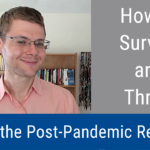Gleb Tsipursky
Best Return to Office Plan: A Team-Led Approach
The best practice on the return to office plan involves a team-led hybrid-first model with some fully remote options. That means empowering lower-level team leaders to choose the work arrangement that best serve their team’s needs
Why Do So Many Leaders Screw Up the Return to the Office?
Leaders can fall prey to dangerous judgment errors which can cause them to wrongly assess their employees’ needs. Significant research shows that employees want to continue working remotely after the pandemic.
What Influences Your Shopping Choices? (Video and Podcast)
When it comes to shopping choices, we overestimate our abilities to keep our impulses in check. You can avoid poor shopping choices by developing a host of shopping mental skills. That's the key take-away message of this episode of the Wise Decision Maker Show, which describes what influences your shopping choices.
What Do Employees Want When They Return to the Office? (Video and Podcast)
Our assumptions about what others want are often incorrect due to the cognitive bias called the false consensus effect. Extensive research shows that most employees place a premium on telework and work-life quality after the pandemic. That's the key take-away message of this episode of the Wise Decision Maker Show, which describes what employees want when they return to the office.
How to Cope With Depression in the Post-Pandemic Recovery (Video and Podcast)
To cope with depression in the post-pandemic recovery, find new ways of fulfilling your needs for exploration, love, and meaning and purpose. That's the key take-away message of this episode of the Wise Decision Maker Show, which describes how to cope with depression in the post-pandemic recovery.
What Do Employees Want When They Return to the Office?
Our assumptions about what others want are often incorrect due to the cognitive bias called the false consensus effect. Extensive research shows that most employees place a premium on telework and work-life quality after the pandemic.
How to Cope With Depression in the Post-Pandemic Recovery
To cope with depression in the post-pandemic recovery, find new ways of fulfilling your needs for exploration, love, and meaning and purpose.
How to Defeat Work-From-Home Burnout and Zoom Fatigue
Protect your company from the disastrous effects of work-from-home burnout and Zoom fatigue by a strategic shift toward virtual work being the new normal rather than an emergency measure
How to Survive and Thrive During the Post-Pandemic Recovery (Video and Podcast)
As we continue to emerge from the COVID-19 pandemic and adjust to the post-pandemic world, it's important to identify and meet your basic needs. That's the key take-away message of this episode of the Wise Decision Maker Show, which describes how to survive and thrive during the post-pandemic recovery.
Why Do Smart People Deny Serious Risks (and What to Do About It) (Video...
When dealing with smart people who deny serious risks, focus on their emotions, help them acknowledge reality, and positively reinforce their acceptance of risks. That's the key take-away message of this episode of the Wise Decision Maker Show, which describes why smart people deny serious risks and what to do about it.











